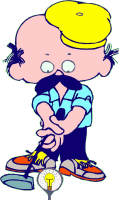|
|
Creative Golfing |
|
|
||
|
1353 The first recorded reference to chole, the probable antecedent of golf. It is a derivative of hockey played in Flanders (Belgium). 1421 A Scottish regiment aiding the French against the English at the Siege of Bauge is introduced to the game of chole. Hugh Kennedy, Robert Stewart and John Smale, three of the identified players, are credited with introducing the game in Scotland. 1457 Golf, along with football, is banned by the Scots Parliament of James II because it has interfered with military training for the wars against the English. 1470 The ban on golf is reaffirmed by the Parliament of James III. 1491 The golf ban is affirmed again by Parliament, this time under King James IV. 1502 With the signing of the Treaty of Glasgow between England and Scotland, the ban on golf is lifted. James IV makes the first recorded purchase of golf equipment, a set of clubs from a bow-maker in Perth, Scotland. 1513 Queen Catherine of England, in a letter to Cardinal Wolsey, refers to the growing popularity of golf in England. 1527 The first commoner recorded as a golfer is Sir Robert Maule, described as playing on Barry Links (near the modern-day Carnoustie). 1552 The first recorded evidence of golf at St. Andrews. 1553 The Archbishop of St. Andrews issues a decree giving the local populace the right to play golf on the links at St. Andrews. 1567 Mary, Queen of Scots, seen playing golf shortly after the death of her husband Lord Darnley, is the first known female golfer. 1589 Golf is banned in the Blackfriars Yard, Glasgow. This is the earliest reference to golf in the west of Scotland. 1592 The City of Edinburgh bans golfing at Leith on 1592 (continued) Sunday "in tyme of sermonis." 1618 Invention of the feathery ball. 1618 King James VI of Scotland and I of England confirms the right of the populace to play golf on Sundays. 1621 First recorded reference to golf on the links of Dornoch (later Royal Dornoch), in the far north of Scotland. 1641 Charles II is playing golf at Leith when he learns of the Irish rebellion, marking the beginning of the English Civil War. He finishes his round. 1642 John Dickson receives a license as ball-maker for Aberdeen, Scotland. 1659 Golf is banned from the streets of Albany, New York-the first reference to golf in America. 1682 In the first recorded international golf match, the Duke of York and John Paterstone of Scotland defeat two English noblemen in a match played on the links of Leith. Andrew Dickson, carrying clubs for the Duke of York, is the first recorded caddy. 1687 A book by Thomas Kincaid, Thoughts on Golve, contains the first references on how golf clubs are made. 1721 Earliest reference to golf at Glasgow Green, the first course played in the west of Scotland. 1724 "A solemn match of golf" between Alexander Elphinstone and Captain John Porteous becomes the first match reported in a newspaper. Elphinstone fights and wins a duel on the same ground in 1729. 1743 Thomas Mathison's epic The Goff is the first literary effort devoted to golf. 1744 The Honourable Company of Edinburgh Golfers is formed, playing at Leith links. It is the first golf club. The City of Edinburgh pays for a Silver Cup to be awarded to the annual champion in an open competition played at Leith. John Rattray is the first champion. 1754 Golfers at St. Andrews purchase a Silver Cup for an open championship played on the Old Course. Bailie William Landale is the first champion. The first codified Rules of Golf published by the St. Andrews Golfers (later the Royal & Ancient Golf Club). 1759 Earliest reference to stroke-play, at St. Andrews. Previously, all play was match. 1764 The competition for the Silver Club at Leith is restricted to members of the Honourable Company of Edinburgh Golfers. The first four holes at St. Andrews are combined into two, reducing the round from twenty-two holes (11 out and in) to 18 (nine out and in). St. Andrews is the first 18-hole golf course, and sets the standard for future courses. 1766 The Blackheath Club becomes the first golf club formed outside of Scotland. 1767 The score of 94 returned by James Durham at St. Andrews in the Silver Cup competition sets a record unbroken for 86 years. 1768 The Golf House at Leith is erected. It is the first golf clubhouse. 1773 Competition at St. Andrews is restricted to members of the Leith and St. Andrews societies. The Royal Burgess Golfing Society of Edinburgh is formed. 1774 Thomas McMillan offers a Silver Cup for competition at Musselburgh. He wins the first championship. The first part-time golf course professional (at the time also the greenkeeper) is hired, by the Edinburgh Burgess Society. 1780 The Aberdeen Golf Club (later Royal Aberdeen) is formed. 1783 A Silver Club is offered for competition at Glasgow. 1786 The South Carolina Golf Club is formed in Charleston, the first golf club outside of the United Kingdom. The Crail Golfing Society is formed. 1787 The Bruntsfield Club is formed. 1788 The Honourable Company of Edinburgh Golfers requires members to wear club uniform when playing on the links. 1797 The Burntisland Golf Club is formed. The town of St. Andrews sells the land containing the Old Course (known then as Pilmor Links), to Thomas Erskine for 805 pounds. Erskine was required to preserve the course for golf. 1806 The St. Andrews Club chooses to elect its captains rather than award captaincy to the winner of the Silver Cup. Thus begins the tradition of the Captain "playing himself into office," by hitting a single shot before the start of the annual competition. 1810 Earliest recorded reference to a women's competition at Musselburgh. 1820 The Bangalore Club is formed, the first club outside of the British Isles. 1824 The Perth Golfing Society is formed, later Royal Perth (the first club so honored). 1826 Hickory imported from America is used to make golf shafts. 1829 The Calcutta Golf Club (later Royal Calcutta) is formed. 1832 The North Berwick Club is founded, the first to include women in its activities, although they are not permitted to play in competitions. 1833 King William IV confers the distinction of "Royal" on the Perth Golfing Society; as Royal Perth it is the first Club to hold the distinction. The St. Andrews Golfers ban the stymie, but rescind the ban one year later. 1834 William IV confers the title "Royal and Ancient" on the Golf Club at St. Andrews. 1836 The Honourable Company of Edinburgh Golfers abandons the deteriorating Leith Links, moving to Musselburgh. The longest driver ever recorded with a feathery ball, 361 yards, is achieved by Samuel Messieux at Elysian Fields. 1842 The Bombay Golfing Society (later Royal Bombay) is founded. 1844 Blackheath follows Leith in expanding its course from five to seven holes. North Berwick also had seven holes at the time, although the trend toward a standard eighteen had begun. 1848 Invention of the "guttie," the gutta-percha ball. It flies farther than the feathery and is much less expensive. It contributes greatly to the expansion of the game.
|
||

